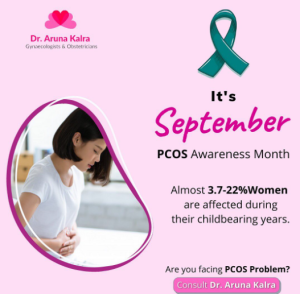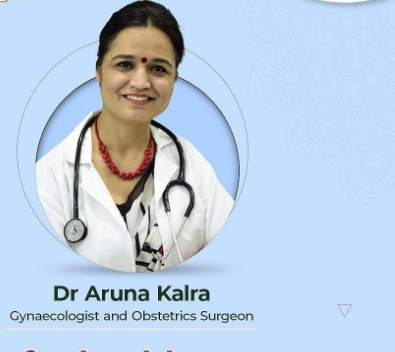Table of Contents
Health Desk, Delhi Magazine: PCOS problem is found in many women and girls but very few people know about it. Polycystic ovary syndrome is commonly known as (PCOS). Also called polycystic ovary disorder (PCOD). Today, we discuss about PCO with Dr. Aruna Kalra.
-
What is PCOS and what is its prevalence?
A. When a woman has PCOS, she develops hormonal imbalances during her reproductive years (between ages 12 and 51). Increased amounts of male hormones can make it harder for women to become pregnant, induce irregular ovulation, and create abnormal hair growth on their bodies and faces all at once. Diabetes and heart disease may develop as a result of this over time. PCOS is a serious medical condition that requires surgical intervention or other suitable medical treatment.
One in five Indian women, according to studies, suffer either PCOS or PCOD.

-
How are PCOS and PCOD similar and different from each other with respect to causative factors, impact on pregnancy, etc?
A. Differences between PCOS and PCOD
-
Disease V/S Disorder
It has been highlighted that an unhealthy lifestyle is frequently the cause of PCOD. Women of all ages are susceptible to PCOD, which is a common disorder. PCOS, on the other hand, is not particularly common.
-
Damage Control
Even if each illness does not yet have a specific treatment, PCOD can nearly totally be cured with a healthy lifestyle and regular exercise. On the other side, there are some situations where treating PCOS may need surgery. Compared to PCOD, PCOS treatment is significantly more complicated.
-
More Severe
Despite the fact that both diseases have similar symptoms, PCOS is more severe than PCOD. Type 2 diabetes, heart disease, high blood pressure, and, in advanced stages, endometrial cancer are among the serious adverse effects of the former.
-
Infertility and Ovulation
PCOS patients have serious reproductive problems. The inability of women with PCOS to ovulate regularly makes pregnancy challenging. If they become pregnant, there is a possibility of miscarriage, premature birth, or pregnancy problems. Contrarily, PCOD makes it somewhat more difficult for women to conceive but poses no significant risks.
Similarities:
Both medical conditions affect women between the ages of 12 and 51 who are fertile, have similar symptoms, and are related to the ovaries and hormonal imbalance.
In both cases, PCOD and PCOS, losing weight, eating a good diet free of processed and junk food, and exercising regularly have shown amazing improvement over time. With a healthy diet and prescribed medications, you can limit the damage your body sustains or produces.
-
What are the signs and symptoms of PCOS?
A.Some women get to know that they are suffering from PCOS around the time they get their first period. Others don’t find out about their symptoms until they’ve gained a lot of weight or are having trouble getting pregnant. The most prevalent signs of PCOS in females include the following:
- Abnormal menstruation (Oligomenorrhea)
- Absence of menstruation or skipped periods (Amenorrhea)
- Extreme menstrual bleeding (Menorrhagia)
- Excessive development of hair (face, body – including on back, belly, and chest)
- Acne (face, chest, and upper back)
- Gaining weight
- Hair fall (hair on the scalp gets thinner and fall out)
- Skin coloration (Neck, in the groin, and under the breasts)
- What are the preventative measures that one can take and treatment options available for PCOS?
A.The goal of PCOS treatment is to address your unique problems, such as irregular periods, obesity, infertility, acne, or hirsutism. Treatment usually begins with changes in lifestyle, such as diet, exercise, and weight loss. Your menstrual cycle may be impacted by even a slight 5–10% body weight drop.
The treatment plan will be determined by the symptoms, such as metabolic problems, acne, and hair growth. This includes:
- Utilize medication to control menstruation in order to treat hormonal dysregulation and insulin resistance
- Through oral medications and injections, ovulation induction (the quality and quantity of the ovulation) is accomplished.
- Using fertility medications to treat infertility
- Reducing uncontrollable hair growth
- Remedies for acne and discoloration of the skin
- Ovarian drilling, a laparoscopic operation, is used to remove androgen-producing tissue from the ovaries in PCOS patients who have not responded to hormonal therapy.
Any diet that helps you reduce weight can help your condition. Additionally, shedding kilos helps lower cholesterol, insulin levels, and the risk of developing diabetes and heart disease.
By engaging in moderate exercise for 20 minutes, five days a week, women can lose weight. In addition to increasing insulin and ovulation levels, exercise induces weight reduction.
The symptoms of PCOS can be controlled with the earliest identification and usage of the best treatment options. A healthy lifestyle must be maintained to effectively treat hormone imbalance and related diseases.
Dr.Aruna Kalra is a famous Gynaecologist and Obstetrics Surgeon.She brings 25 years of experience in her field of practice whichmakes her the best in her field.Her expertise lies in minimally invasive gynaecological surgeries, high-risk pregnancies and vaginal birth after caesarean (VBAC,) and Scarless Laparoscopic Surgery.Dr.Aruna is currently working with CK Birla Hospital, Gurugram as a Director and Senior Gynaecologist Surgeon. She is also the MD of Mums Clinic in Gurugram.

